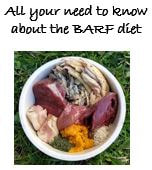THE PRINCIPLES OF FEEDING DOGS CORRECTLY
By. Dr. M. Greenberg (Accredited Animal Behaviour Consultant (ABC of SA™)
Preamble:
Dogs are not cooperative feeders. Instinctively dogs exhibit passive or active food aggression/dominance which is exhibited in several ways:
Overeating or having access to a permanent buffet predisposes dogs and cats to numerous disorders:
Possession of food is 9/10 of the law|
Feeding principles
Every dog must be fed a diet according to its age, health, activity and medical needs.
Humans eat badly themselves so how much hope do their pets have?!
Dogs are not cooperative feeders. Instinctively dogs exhibit passive or active food aggression/dominance which is exhibited in several ways:
- Direct aggression towards any other dog attempting to eats in its presence
- Taking over the food bowl and ingesting the food
- Exhibiting the kinesics (body language) of threatening behaviour hindering the other dog/s from eating or approaching their food dish for fear of attack
- Carnivores are not physiologically designed to eat ad lib, although they would if they could.
Overeating or having access to a permanent buffet predisposes dogs and cats to numerous disorders:
- No association with owner’s control over food. Owner loses a degree of importance in pet’s life.
- Diabetes
- Urinary tract disease
- Obesity
- Degenerative Joint Disease
- Pancreatic and liver disease
- Cardiopulmonary stress
Possession of food is 9/10 of the law|
Feeding principles
Every dog must be fed a diet according to its age, health, activity and medical needs.
- The food must be weighed out every day according to the current weight of the dog if it is in good condition or, if overweight, then according to the weight it should be. Balance this with exercise.
- Every item including titbits must be included in the “weigh-in” of the food for the day.Every dog must be fed in a different venue where they cannot see each other and a barrier exists between them e.g. a shut door. This is to alleviate food aggression. Active food aggression is when the one dog charges across, chases the other dog away from the food bowl and either guards it or eats it. Passive food aggression is when the food dominant dog conveys postures, sounds, kinesics etc. that threatens the other dog/s in such a way that they are too fearful to eat in the “aggressor’s” presence.
- In multi-canine households the fact that some dogs are obese, some very thin and others ranging in between clearly indicates communal feeding.
- Never add anything else to the food, unless indicated on the packaging. The packaging offers clear feeding instructions with details of the ingredients. Why deviate from this?
Most people feed scraps, extras mostly from being anthropomorphic (“Shame, they need a variety” when, in fact, animals are creatures of habit!) Where does it read on the packaging e.g. “add chicken and rice” or “throw some gravy over it” or “add polony or mincemeat to give it a taste” etc? Before feeding a dog anything above its scientifically formulated food think for a moment whether the extras/titbits will be of any benefit in the short-term or long-term. Do you have a degree in canine nutrition that no one else is aware of? Think of the health complications that may occur. Is this obsessive compulsive feeding of titbits an expression of love for the dog or just a means to rot its teeth, irritate its bowels and be a candidate for pancreatitis? - Canned food is a good idea only if the pet is recuperating from illness, is too young to chew on pellets or too old to gnaw on the dry food. Must use the tins from the same manufacturer if dry food is being used.
- Canned food fed regularly will require the dog’s or cat’s teeth to be brushed to prevent dental tartar, eroded gums and rotten teeth.
- Food dishes must be removed after 10 minutes. Only water available.
- As a guideline: 3 meals per day up to 6 months (8 hours apart), 2 meals per day (12 hours apart) up to 9 months then one meal per day
- A dog fed late at night will be quieter.
- Bones should be fed raw. Cooked bones fragment and cause digestive disturbances e.g. blockages, obstructions.
- Never to feed chop bones, T-bones.
- Bones should be very large so that they cannot be easily swallowed and used to mostly gnaw on.
- Dogs may kill each other over a bone so one should have 3-5 bones for 2 dogs and ensure that there is no resource guarding, or likelyhood of aggression. If this is a possibility, then bones to be given to dogs completely separately.
- It is an attractive item to occupy puppies while owners are away from the house i.e. a diversion from
Humans eat badly themselves so how much hope do their pets have?!
|
The BARF diet for is often mentioned, but not all people know what this consists of. This article will give you the understanding of what it consists of.
|
Alfalfa is an ingredient in many commercially-available dog and cat foods, and consumers are beginning to ask whether this forage really belongs in their pet's diet.
|
There has long been debate as to whether the dog is a carnivore or an omnivore, which leads to a lot of confusion as to what type of food is best for their dogs. This articles explains the differences and will increase your knowledge.
|






